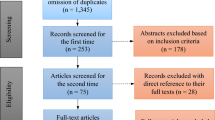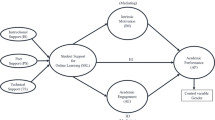Abstract
To pilot a peer literacy program, a pretest-posttest study was conducted involving seventy (70) students from Arellano High School as tutees and 12 De La Salle University-Manila College of Education students as reading tutors. Though the results suggest the lack of impact of the Program on the Reading Grades of the tutees, the tutors’ journals reveal that the tutors benefited more from the program. The problems in using the National Service Training Program or NSTP as the vehicle in piloting the program were identified and based on this, the study suggests ways to improve the content and delivery of future NSTP Peer Literacy Programs.
Similar content being viewed by others
References
Baker, S., Gersten, R. and Keating, T. (2000). When less may be more: A 2-year longitudinal evaluation of a volunteer tutoring program requiring minimal training,Reading Research Quarterly, 35, 4, pp. 494–511.
Bigge, M. and Shermis, S. (1999).Learning theories for teachers. New York: Longman, Inc.
Boise State University. Peer tutoring. Retrieved June 1, 2006, from http://www.educ.uidaho.edu/bestpractices/peer_train.html
Boudouris, C. (2005). Peer tutoring: Positive peer interactions.Ohio Reading Teacher. University Heights, 37, 1, 11–19. Retrieved June 8, 2006 ProQuest document ID 996945111
Bruffee, K. (1999).Collaborative Learning. Higher Education, Interdependence, and the Authority of Knowledge (2 nd ed.). Baltimore and London: The Johns Hopkins University Press.
Burks, M. (2004). Effects of classwide peer tutoring on the number of words spelled correctly by students with LD.Intervention in School and Clinic, 39, 5, pp. 301–304. Retrieved June 8, 2006 ERIC Number EJ693675. Center for Effective Collaboration and Practice. Classwide peer tutoring. Information for families. Retrieved June 1, 2006 from http://cecp.air.org/familybriefs/docs/PeerTutoring. pdf
Davenport, S., Arnold, M., and Lassmann, M. (2004). The impact of cross-age tutoring on reading attitudes and reading achievement,Reading Improvement, 41, 1, pp. 3–12. Retrieved June 8, 2006 ProQuest document ID: 622245961
Fitzgerald, J. (2001). Can minimally trained college student volunteer help young at-risk children to read better?Reading Research Quarterly, 36, 1, pp. 28–47.
Gartner, A. and Riessman, F. (1993). Peer tutoring: Toward a new model. ERIC Digest. Retrieved June 1, 2006 ERIC Id ED362506.
Kalkowski, M. (2001). Peer and cross-age tutoring.School Improvement Research Series. Retrieved February 7, 2005 from http://www.nwrel.org/scpd /sirs/9/c018.html. The Lawphil Project - Arellano Law Foundation. (Jan. 23, 2002). Republic Act No. 9163. An Act establishing the National Service Training Program (NSTP). Retrieved June 7, 2006 from http://www.lawphil.net/statues/ repacts/ra2002/ra_9163_2002.html
Lippitt, P. (1976). Learning through cross-age helping: Why and how. In V. Allen (Ed.).Children as teachers. Theory and research on tutoring. New York: Academic Press, pp. 157–168.
Medcalf, J., Glynn, T., Moore, D. (2004). Peer tutoring in writing: A school systems approach.Educational Psychology in Practice, 20, 2, pp. 157–178. Retrieved June 8, 2006 ERIC No. EJ680730.
Myrick, R. & Bowman, R. (1981).Children helping children: Teaching students to become friendly helpers. Minneapolis, Minnesota: Educational Media Corp.
Murray, F. (1994). Why understanding the theoretical basis of cooperative learning enhances teaching success. In J.S. Thousand, R. A. Villa and A.I. Nevin. (Eds.).Creativity and collaborative learning: A practical guide to empowering students and teachers. Baltimore: Paul H. Brookes Pub.
Omrod, J. E. (1995).Educational psychology. Principles and applications. New Jersey and Ohio: Prentice-Hall.
Pyatt, G. (2002). Cross-school mentoring: Training and implementing a peer mentoring strategy.Mentoring & Tutoring, 10, 2, 171–177.
Reed, R. (n.d.).Peer-tutoring programs for the academically deficient student in higher education. Berkeley, California: University of California Berkeley Center for Research and Development in Higher Education.
Schmuck, R. A. and Schmuck, P. A. (1997).Group processes in the classroom (7 th ed.). Dubuque, Iowa: McGraw Hill.
Snowman, J. and Biehler, R. (2000).Psychology applied to teaching (9 th ed.). Boston and New York: Houghton Mifflin
Thomas, R. (1993). Cross-age and peer tutoring. ERIC Digest. Retrieved June 1, 2006 ERIC Clearinghouse in Reading, English, and Communication Digest # 78.
Topping, K. (1996). Section 1. The effectiveness of peer tutoring in higher and further education: A typology and review of the literature. From: Effective peer tutoring in further and higher education, SEDA Paper 95. Retrieved June 7, 2006 from http://www.londonmet.ac.uk/ deliberations/seda-publications/topping.cfm
Topping, K. and Bryce, A. (2004). Cross-age peer tutoring of reading and thinking: An influence on thinking skills.Educational Psychology, 24, 5, pp. 595–621.n Retrieved June 8, 2006 ERIC No. EJ680614.
Topping, K. and Bamford, J. (1998).The paired maths handbook. Parental involvement and peer tutoring in mathematics. London: David Fulton Pubs.
Wasik, B. (1998). Volunteer tutoring programs in reading: A review.Reading Research Quarterly, 33, 266–292.
Whitman, N. (1988).Peer teaching: To teach is to learn twice. ASHE-ERIC Higher Education Report No. 4. Washington, D.C: Association for the Study of Higher Education.
Author information
Authors and Affiliations
Corresponding author
Rights and permissions
About this article
Cite this article
Miciano, R.Z. Piloting a peer literacy program: Implications for teacher education. Asia Pacific Educ. Rev. 7, 76–84 (2006). https://doi.org/10.1007/BF03036786
Received:
Revised:
Accepted:
Issue Date:
DOI: https://doi.org/10.1007/BF03036786




